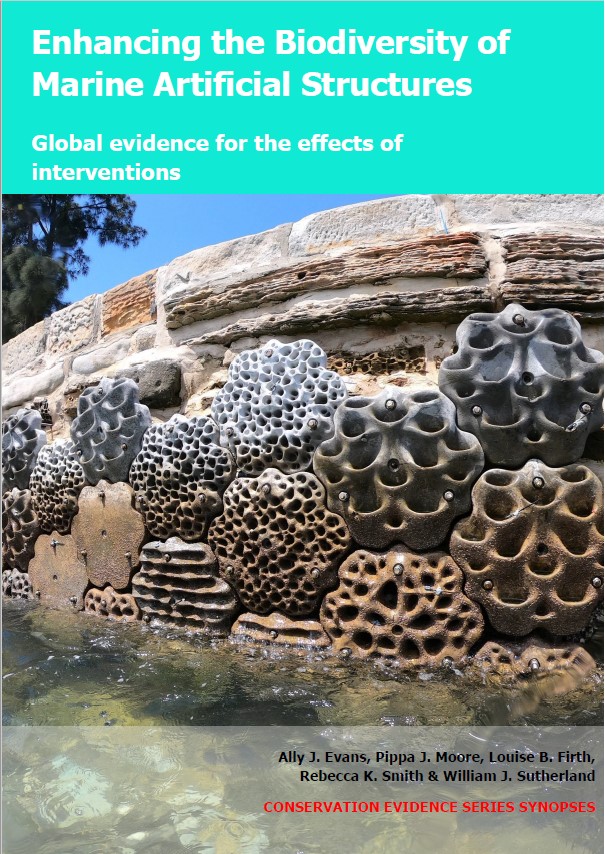Create textured surfaces (≤1 mm) on intertidal artificial structures
-
Overall effectiveness category Awaiting assessment
-
Number of studies: 4
View assessment score
Hide assessment score
How is the evidence assessed?
-
Effectiveness
not assessed -
Certainty
not assessed -
Harms
not assessed
Study locations
Supporting evidence from individual studies
A replicated, randomized, controlled study in 2010 on two intertidal rocky reefs on open coastlines in the Celtic Sea and the English Channel, UK (Coombes et al. 2015) found that creating textured surfaces on settlement plates increased the abundance of barnacles Chthamalus spp. on plates. After six months, average barnacle abundance was higher on scrape-textured plates (226–351/plate) than spray-textured plates (124–228/plate), and higher on both than on untextured plates (59–152/plate). Concrete settlement plates (50 × 50 mm) were made with and without textured surfaces, created by scraping with a wire brush or spraying with a water jet. Ten plates with each of ‘scrape-textured’, ‘spray-textured’ and untextured surfaces were randomly arranged horizontally at midshore on each of two rocky reefs in May 2010. Barnacles on plates were counted from photographs after six months.
Study and other actions testedA replicated, paired sites, controlled study in 2008–2010 on an intertidal breakwater on open coastline in the North Sea, Netherlands (Paalvast 2015a) reported that settlement plates with textured surfaces supported similar abundances of macroalgae and invertebrates to plates without texture. Data were not statistically tested. After 28 months, there were no clear differences in macroalgal or invertebrate abundances on plates with and without textured surfaces (data not reported). Concrete settlement plates (250 × 250 mm) were made with and without textured surfaces using a mould. Plates with texture had either fine (0.5 mm) or coarse (1 mm) texture. One of each and one plate without texture were placed on each of 10 vertical surfaces on each side of a concrete-block breakwater (wave-exposed, wave-sheltered) in May 2008. One plate with fine texture and one without were also placed on each of 10 horizontal surfaces on each side of the breakwater. On the wave-exposed side, plates were at mid-highshore, while on the wave-sheltered side, plates were at low-midshore. Macroalgae and invertebrates on plates were counted during low tide over 28 months.
Study and other actions testedA replicated, paired sites, controlled study in 2009 on 14 jetty pilings in Rotterdam Port in the Rhine-Meuse estuary, Netherlands (Paalvast 2015b) reported that settlement plates with textured surfaces supported similar abundances of macroalgae and invertebrates to plates without texture. Data were not statistically tested. After nine months, there were no clear differences in macroalgal or invertebrate abundances on plates with and without textured surfaces (data not reported). Concrete settlement plates (250 × 250 mm) were made with and without textured surfaces using a mould. One plate with texture and one without were attached to vertical surfaces on each of 14 wooden pilings at lowshore in March 2009. Macroalgae and invertebrates on plates were counted during low tide over nine months.
Study and other actions testedA replicated, randomized, controlled study in 2016–2017 on three intertidal seawalls in the Clyde and Forth estuaries and on open coastline in the English Channel, UK (MacArthur et al. 2019) found that creating textured surfaces on seawall surfaces, along with using environmentally-sensitive material, had mixed effects on macroalgae and invertebrate species richness and invertebrate abundances, depending on the type of texture created and the site. After 18 months, plates with and without texture supported similar macroalgae and mobile invertebrate species richness in seven of eight comparisons (textured: 1–2 species/plate; untextured: 1/plate). At one site (1 comparison), cast-textured plates supported more species (2/plate) than untextured plates (1/plate). Textured and untextured plates also supported similar mobile invertebrate abundance in five of eight comparisons (textured: 1–2 individuals/plate; untextured: 1–3/plate). At one site (3 comparisons), textured plates supported more mobile invertebrates (3–5 individuals/plate) than untextured plates (1/plate). Barnacle (Cirripedia) cover was higher on plates with texture (67–95%) than without (22–83%) in six of eight comparisons, but did not significantly differ at one site (2 comparisons; textured: 46–51%; untextured: 22%). It is not clear whether these effects were the direct result of creating texture or using environmentally-sensitive material on some plates. Settlement plates (150 × 150 mm) were made with and without textured surfaces, created by scraping with a wire brush, moulding with barnacle-shaped impressions, or casting with crushed foil. ‘Scrape-textured’, ‘mould-textured’ and untextured plates were concrete, while ‘cast-textured’ plates were limestone-cement (environmentally-sensitive material). Eight plates with each of scrape-textured, mould-textured and untextured surfaces were randomly arranged at upper-midshore on each of three vertical concrete seawalls in April–May 2016. Eight cast-textured plates were attached on each of two walls. Macroalgae and invertebrates on plates were counted from photographs over 18 months.
Study and other actions tested
Where has this evidence come from?
List of journals searched by synopsis
All the journals searched for all synopses
This Action forms part of the Action Synopsis:
Biodiversity of Marine Artificial Structures
Biodiversity of Marine Artificial Structures - Published 2021
Enhancing biodiversity of marine artificial structures synopsis





)_2023.JPG)














